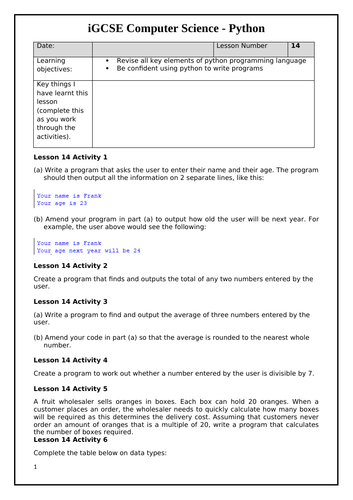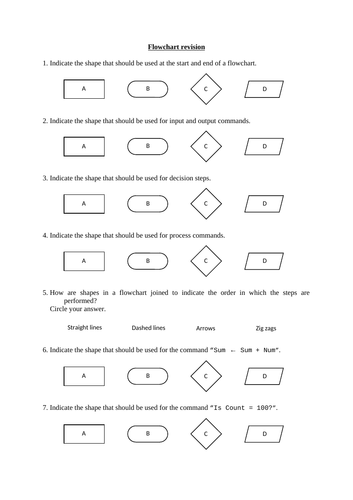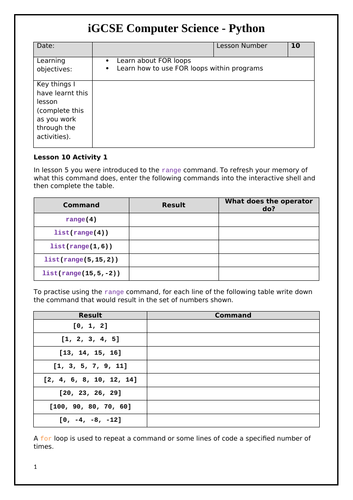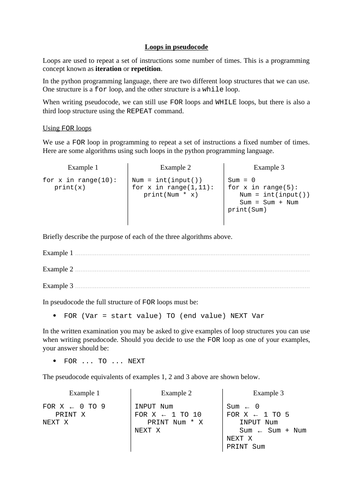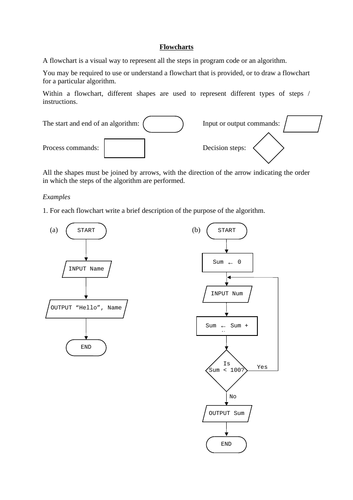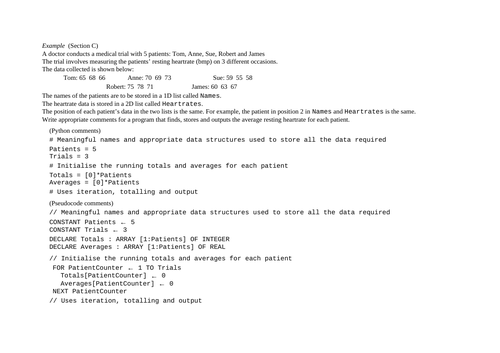31Uploads
11k+Views
7k+Downloads
All resources

Procedures and functions in Python
This booklet introduces how procedures and functions are used within Python, giving pupils lots of programming activities to practise using them.
The booklet is designed for pupils to work through independently, so they can progress and learn at their own pace and you just support and guide as necessary.
The booklet assumes that pupils are familiar with conditional statements, FOR and WHILE loops, and arrays or lists.
Solutions are provided in a separate booklet.

Python revision activities
This booklet of activities is designed to help your students revise the key Python programming skills they need for the iGCSE course.
It covers inputs and outputs, calculations, data types, comparison operators, IF statements, FOR loops, WHILE loops, and lists/arrays (1D and 2D).
There are over 30 activities for pupils to work through, including many programming tasks.
The booklet is designed for pupils to work through independently, so they can progress and learn at their own pace and you just support and guide as necessary.
This resource has been updated for the new specification for exams from 2023, so includes some activities working with 2D lists.
Solutions to all activities are included in a separate booklet.

WHILE loops in Python
This booklet introduces how WHILE loops are used within Python, giving pupils lots of programming activities to practise using them.
The booklet is designed for pupils to work through independently, so they can progress and learn at their own pace and you just support and guide as necessary.
Solutions are provided in a separate booklet.

Flowcharts revision
This 7-page resource is designed to help pupils revise the topic of flowcharts for the iGCSE Computer Science course.
It begins with 12 example questions to work through as a group, followed by an exercise with another 12 questions for pupils to attempt themselves.
Solutions to the exercise are included, and solutions to the examples are included in the teacher’s version.

Christmas activity with Python
A Christmas-themed activity where students will use/learn programming skills.
This booklet leads students through the creation of a Christmas scene using drawing commands with Python turtle. It does not require any prior programming knowledge, and is designed so that students can progress independently through the tasks.
When I use this with my year 10 classes it takes them around 1 hour to complete.
Example solutions to all the tasks are included in a separate booklet.

FOR loops in Python
This 8-page booklet introduces how FOR loops work within Python, giving pupils lots of practise using them in programming activities. Nested FOR loops are also covered.
The booklet is designed for pupils to work through independently, so they can progress and learn at their own pace and you just support and guide as necessary.
Solutions are included in a separate booklet.

Iteration (FOR, WHILE & REPEAT loops) in pseudocode (iGCSE Computer Science)
This 23 page resource is designed to introduce students to the use of iteration (FOR, WHILE & REPEAT loops) in pseudocode, as required for the new iGCSE Computer Science specification (from 2023).
The first section covers FOR loops. Some simple FOR loops using Python are given as examples, and then the equivalent commands in pseudocode. Exercise A has over 20 questions for students to practise writing algorithms that include use of FOR loops, including some questions where data is stored in 1D or 2D lists - useful practice in preparation for the 15-mark unseen scenario question at the end of paper 2.
The next section covers WHILE loops. Some simple WHILE loops using Python are given as examples, and then the equivalent commands in pseudocode. Exercise B has over 10 questions for students to practise writing algorithms that include use of a WHILE loop.
The final section covers REPEAT loops. Some simple REPEAT loops in pseudocode are given as examples, and then a contrast is made between WHILE and REPEAT loops. Exercise C has over 10 questions for students to practise writing algorithms that include use of a REPEAT loop.
Full solutions to the exercises are included.

Flowcharts
This 12-page resource introduces how flowcharts can be used as a visual representation of a program, tailored towards the iGCSE Computer Science course.
After introducing the different shapes used for different types of steps or instructions, there are some examples to work through as a group, followed by an exercise for pupils to attempt themselves.
Solutions to the exercise are included, and solutions to the examples are included in the teacher version.

Selection in pseudocode (iGCSE Computer Science)
This 19 page resource is designed to introduce students to the use of selection (conditional statements) in pseudocode, as required for the new iGCSE Computer Science specification (from 2023).
The first section covers comparison operators and logical operators. Each command is introduced with some examples and, where appropriate, is compared with equivalent commands in Python. Exercise A has 20 questions for students to practise working with these commands.
The next section focuses on IF statements. The different possible structures of IF statements are introduced with some examples and, where appropriate, are compared with equivalent commands in Python. Exercise B has 19 questions for students to practise writing algorithms that include use of IF statements.
The next section focuses on CASE OF statements. The different possible structures of CASE OF statements are introduced with some examples and, where appropriate, are compared with equivalent commands in Python. Exercise C has 19 questions for students to practise writing algorithms that include use of CASE OF statements.
Full solutions to the exercises are included, and answers to any examples are included in the teacher’s version of the resource.

15 mark unseen scenario question - 0984 iGCSE Computer Science (final question on paper 2)
This resource is designed to help students develop and practise the skills and knowledge needed to answer the final 15-mark question on Paper 2 - a programming task on a particular scenario.
Section A focuses on choosing and defining/declaring appropriate data structures for storing the required data. There are notes with some examples, then a 3-page exercise for students to practise this part of the task.
Section B focuses on identifying the programming technique(s) needed to solve different types of programming tasks. There are notes with some examples, then a 3-page exercise for students to practise this part of the task.
Section C shows students what types of comments they are expected to write to explain their code. It shows the typical structure of comments for both Python and pseudocode, and then there is an example task to work through as a class.
Section D is a chance for students to practise writing full solutions to tasks that involve only 1D lists. There is an example to work through as a class, followed by an exercise with 18 tasks of increasing difficulty, including some tasks that require a procedure or a function.
Section E is a chance for students to practise writing full solutions to tasks that involve 2D lists. There is an example to work through as a class, followed by an exercise with 17 tasks of increasing difficulty, including some tasks that require a procedure or a function.
Full solutions are provided to all the tasks in the exercises, written in both Python and pseudocode. Solutions to the examples are also provided in a separate resource.

1D and 2D arrays / lists in Python
This 25-page booklet covers how 1D and 2D arrays are defined and used in Python. The activities will show pupils how to input data into arrays, sort arrays, find how many elements are in an array, find the index of an element, …
There are nearly 50 activities for pupils to work through, including many programming tasks.
The booklet is designed for pupils to work through independently, so they can progress and learn at their own pace and you just support and guide as necessary.
This resource has been updated for the new specification for exams from 2023. There are 6 activities at the end of the booklet that are designed to help pupils develop the skills and knowledge needed for the 15-mark unseen scenario question at the end of Paper 2.
Solutions to all activities are included in a separate booklet.


